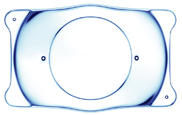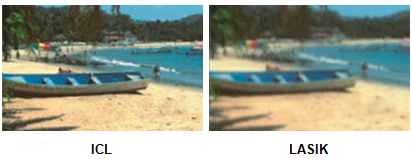Implantable Collamer Lens Service
 There's a big difference between "visual acuity" (6/6 vision is considered normal visual acuity) and "visual quality." Many refractive procedures such as LASIK offer the promise of improved visual acuity but the quality of your vision may vary significantly based on the procedure you choose. The ICL provides vision correction that goes beyond LASIK. It helps you enjoy sharper, clearer, and more vivid vision, with greater depth and dimension.
There's a big difference between "visual acuity" (6/6 vision is considered normal visual acuity) and "visual quality." Many refractive procedures such as LASIK offer the promise of improved visual acuity but the quality of your vision may vary significantly based on the procedure you choose. The ICL provides vision correction that goes beyond LASIK. It helps you enjoy sharper, clearer, and more vivid vision, with greater depth and dimension.
When compared to other refractive surgical procedures, the ICL creates sharper vision. The immediate improvement of vision quality and the remarkably short and painless recovery produces a unique "WOW!" factor in patients.
The "High Definition Vision" delivered by the ICL makes this proven, technologically advanced vision correction procedure the choice for patients who need and expect high quality results. The ICL is clearly the choice for patients with an active lifestyle and those who cannot accept anything less than the highest quality vision.

If you can't settle for "good enough" vision and demand "High Definition Vision," the ICL is clearly the refractive procedure choice for you.
Guidelines to patients desiring ICL procedure:
Good candidates for the ICL include patients who:
- Are between the ages of 18 and 45 years.
- Are nearsighted or farsighted, including those with mild, moderate, and high power with or without occurrence of astigmatism. The Toric ICL™, capable of correcting myopia and astigmatism together and combines two procedures into one.
- Have proper anterior chamber depth and acceptable eye tissue cell density (this will be determined by the eye surgeon or ophthalmologist after a comprehensive eye exam).
- Have not had a change in their eyeglass prescription of more than 0.50 Diopters in 6 months.
- Are not currently pregnant.
- Have no known allergies to medications used during refractive surgery or no other contraindications.
- Have dry eyes, severe myopia, or a thin cornea (non-LASIK candidate).
Consultation
During your first examination we need to dilate your pupils using eye drops. Dilatation of the pupils may temporarily blur the vision of some people for a few hours. Therefore, we advise that you make arrangements for someone else to drive you back home. It would also help if you can get a pair of dark glasses along. Eye examinations normally take time. You may have to spend an hour or more at the hospital . We would appreciate your patience.As an ICL candidate, we will prepare your eyes one to two weeks prior to surgery by using a laser to create a small opening between the lens and the front chamber of your eye (iridotomy). This allows fluid to pass between the two areas, thereby avoiding the buildup of intraocular pressure following the surgery. However, this can be done on the same day of the surgery.
Surgical Procedure
The implantation procedure for the ICL involves a procedure similar to that of cataract surgery but unlike cataract surgery, the ICL procedure does not require the removal of the eye's crystalline lens. The entire procedure for the implantation of the ICL will take about 15 to 30 minutes. Most patients say it is relatively painless because of the numbing agents used. Please bring someone along to drive you home following the procedure.
Topical Anesthesia : On the day of your procedure, prior to surgery, your surgeon will administer topical anesthesia to minimize discomfort, however you may still feel pressure in your eye. Additionally, you may or may not be given a sedative.
Lens Positioning Openings : Once you are comfortable, your surgeon will begin the procedure. First, the surgeon will create one or two small openings at the base of your cornea that will be used to position the lens.
Gel-like Solution : Next, a gel-like substance will be placed inside your eye to protect the eye during lens placement. This gel will be removed at the end of the procedure.
Lens Opening : Following placement of the gel, a small opening will be made, through which the lens will be inserted.
Insertion of Corrective Lens : Prior to the ICL procedure, your corrective lens was selected based on your individual prescription. The lens was folded and loaded into a small cartridge which will now be placed through the incision. As the lens is inserted, it will gently unfold in your eye. Once the lens has fully unfolded, the four corners of the lens will be placed behind your iris. This makes the lens invisible to both you and others.
Completion of Procedure : To complete the procedure, the surgeon will administer eye drops to help prevent infection and inflammation. You will continue to use these drops for several days after your procedure.
Because the incision made during surgery is so small, sutures are typically not needed following the ICL surgery. For comfort and protection, the surgeon may cover the eye with a patch or shield and prescribe drops or medication.
You should not be able to drive immediately after the ICL surgery, so it is important that you arrange for transportation home.
Follow-Up Care after the ICL Procedure : Within 24 hours of undergoing the ICL surgery, you will have a follow-up visit with the ophthalmologist. The surgeon will monitor the eye's internal pressure and will discuss your progress.
Patients need to follow physician instructions, especially regarding the needed use of antibiotics an anti-inflammatory medications during the week following the procedure.
Patients should contact their eye surgeon immediately if they experience severe eye pain or a sudden decrease in vision.Frequently asked questions
- Am I a suitable ICL candidate?
Candidates for the ICL are between 21 and 45 years of age, suffer from myopia (nearsightedness), hyperopia (farsightedness) and or astigmatism and want to experience superior vision correction.
Nearly anyone seeking clearer vision may be a ICL candidate, including those with special or extreme vision correction needs. Please make an appointment if you wish to learn more about the procedure our consultants would be happy to answer your queries.
Women who are pregnant or nursing should wait to have the ICL implanted. - What is Toric ICL?
The Toric ICL is a variant of ICL. Toric ICL corrects your nearsightedness as well as your astigmatism (cylindrical power) in one single procedure. Each lens is custom made to meet the needs of each individual eye.
- What is the success rate of the ICL?
Prior to being placed on the market, the ICL was subject to extensive research and development. Today, more than 65,000 patients worldwide enjoy the benefits of the device. In an USFDA clinical trial, over 99 percent of patients were satisfied with their implant. The ICL has a record of stable, consistently excellent clinical outcomes. The lens has been available internationally for over 12 years.
- Is the procedure painful?
No, most patients state that they are very comfortable throughout the procedure. We use a topical anesthetic drop prior to the procedure and sometimes may choose to administer a light sedative as well.
- What is the ICL made of?
The ICL is made of Collamer®, a highly biocompatible advanced lens material which contains a small amount of purified collagen. Collamer does not cause a reaction inside the eye and it contains an ultraviolet filter that provides protection to the eye.
- What if my vision changes after I receive the ICL?
The ICL allows extreme flexibility of treatment options. If your vision changes dramatically after receiving the implant, it can be removed and replaced. If necessary, another procedure can be performed at any time.
Patients can wear glasses or contact lenses as needed following treatment with the ICL. The implant does not treat Presbyopia (difficulty with reading in people 40 and older), but you can use reading glasses as needed after receiving the ICL.
- Is the ICL visible to others?
No, the ICL is positioned behind the iris (the colored part of the eye), where it is invisible to both you and observers. Only your doctor will be able to tell that vision correction has taken place.
- Will I be able to feel the ICL once it is in place?
The ICL is designed to be completely unobtrusive after it is put in place. It stays in position by itself and does not interact with any of the eye's structures






